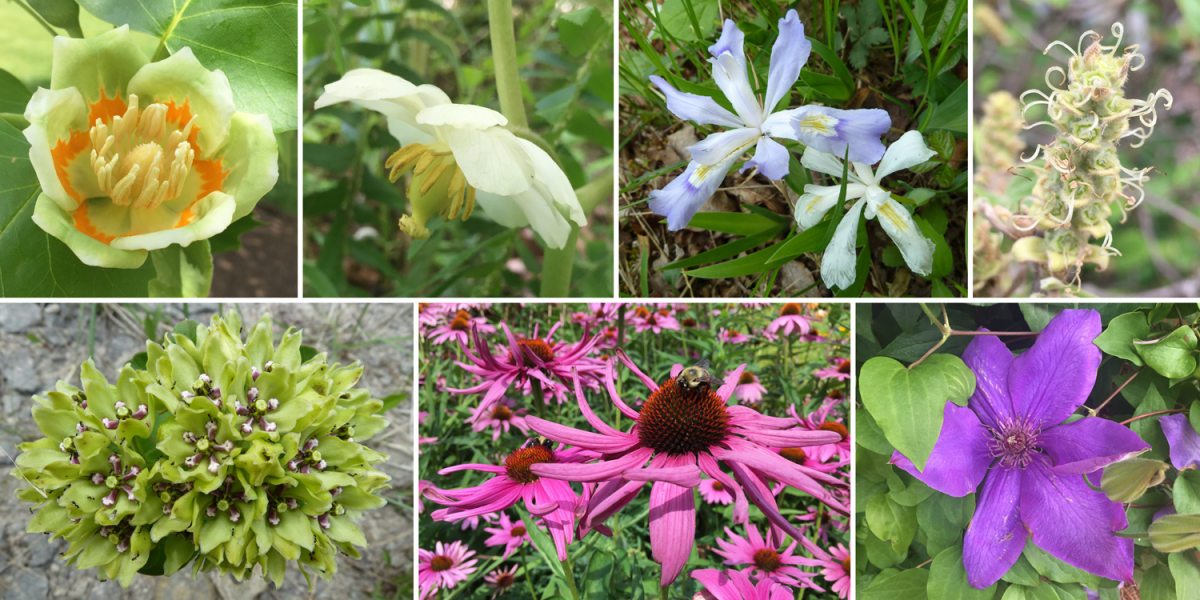Section contents:
Angiosperms (flowering plants) ←
Associated materials:
Feature image: A selection of angiosperms. Top row, from left to right: Tulip poplar (Liriodendron tulipfera), mayapple (Podophyllum peltatum), dwarf lake iris (Iris lacustris), and winter hazel (Fothergilla). Bottom row: Green milkweed (Asclepias viridis), echinacea (Echinacea), and clematis (Clematis). All images by E.J. Hermsen (DEAL).
Overview
Angiosperms, or the flowering plants, are without doubt the most diverse group of modern plants. There may be over 290,000 species of angiosperms alive today, and they are thought to make up about 90% of the world's living embryophyte species (see here). Angiosperms are highly variable in form. They include herbs, shrubs, trees, vines, and succulents. They occur in a great many habitats, from forests, grasslands, and deserts, to aquatic and marine environments.

Angiosperm diversity. Left: Bluets (Houstonia), small herbs growing in the eastern North American forest. Second from left: Manzanita (Arctostaphylos), a small tree growing in an arid region of California, U.S.A. Third from left: Bittersweet (Celastrus), a vine. Right: Sacred lotus (Nelumbo nucifera), an aquatic plant. Credits: Manzanita by E.J. Hermsen & J.R. Hendricks (DEAL); bluets, bittersweet, and sacred lotus by E.J. Hermsen (DEAL).
Angiosperms include amongst the world's tallest, oldest, and most massive plants. Centurion, a mountain ash (Eucalyptus regnans) growing in Tasmania, is the second tallest living tree measured, at about 100 m (328 ft) in height (read more about the tallest angiosperms here). Pando, or the Trembling Giant, a clonal quaking aspen (Populus tremuloides) in Utah, U.S.A., is thought to have been growing continuously for up to 14,000 years and covers over 100 acres (40 hectares) of land (read more here). It is one of the most massive organisms alive! On the other end of the spectrum, many angiosperms are small annual plants whose lives span only a single growing season. Watermeal (Wolffia), an aquatic angiosperm up to 2 mm long, is the smallest angiosperm.
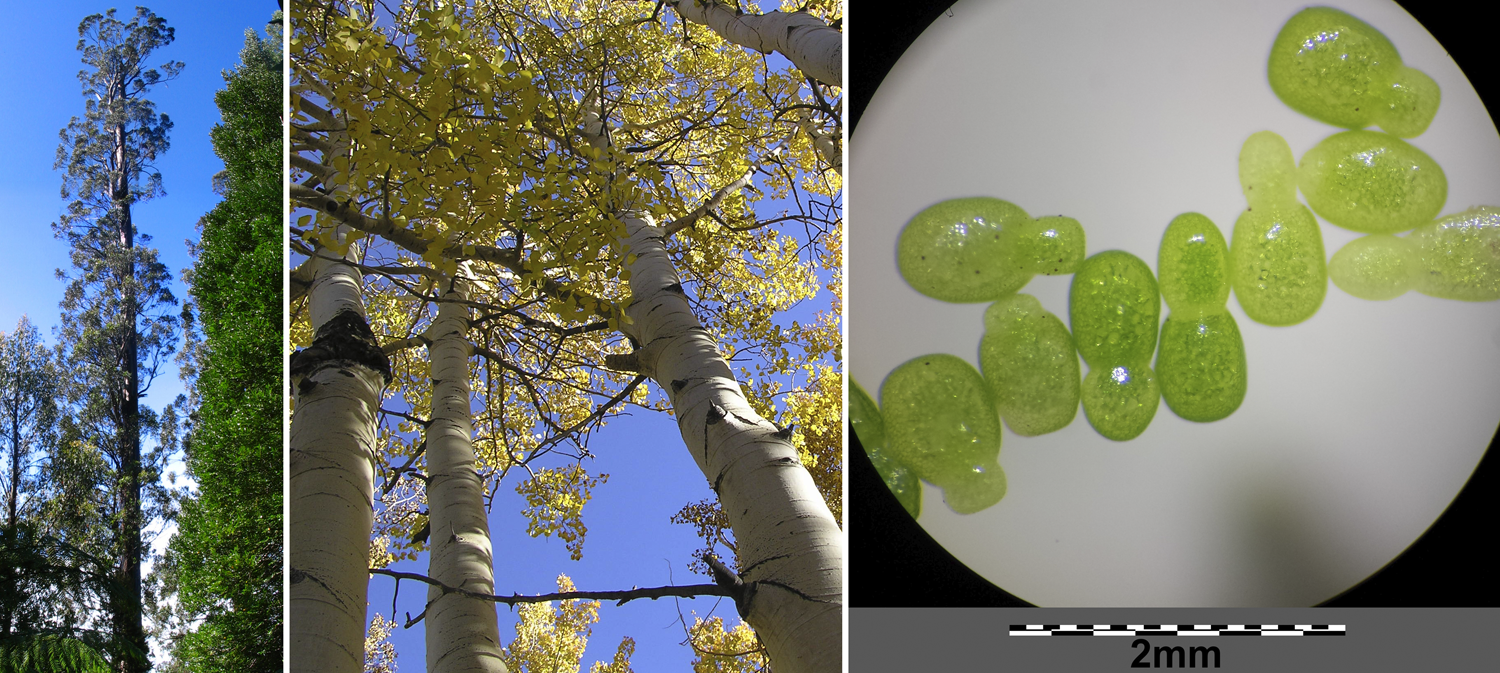
Superlative angiosperms. Left: Centurion, an Australian mountain ash (Eucalyptus regnans) that is the second-tallest tree in the world. Center: Stems of Pando, a quaking aspen (Populus tremuloides) that has been producing new shoots for up to 14,000 years. Right: Watermeal (Wolffia), tiny aquatic plants. Credits: Eucalyptus regnans/Centurion (Eucalyptus99, via Wikimedia Commons, CC BY-SA 4.0); Populus tremuloides/Pando (Scott Catron, via Wikimedia Commons, CC BY-SA 3.0); Wolffia columbiana ss Fischer et al. EfÖLS 2008 (Stefan.Iefnaer, via Wikimedia Commons, CC BY-SA 4.0). Images modified from originals.
Angiosperms are of special interest to humans because they provide many essential and useful products, from food (cereals, fruits, vegetables), to tea, coffee, treats (e.g., table sugar, cocoa), medicines (e.g., quinine, digoxin), herbs (e.g., rosemary, oregano), spices (e.g., cinnamon, nutmeg), oils, fats, natural rubber, wood, clothing fibers (e.g., cotton, hemp, linen), and other products. Their relationships with people are not always beneficial. Some angiosperms are agricultural weeds or invasive pests that blight natural areas. Others are the sources of potent and dangerous poisons (e.g, strychnine) or drugs that are abused (e.g., morphine from the opium poppy is used to make heroin, and cocaine is an alkaloid from the coca plant).
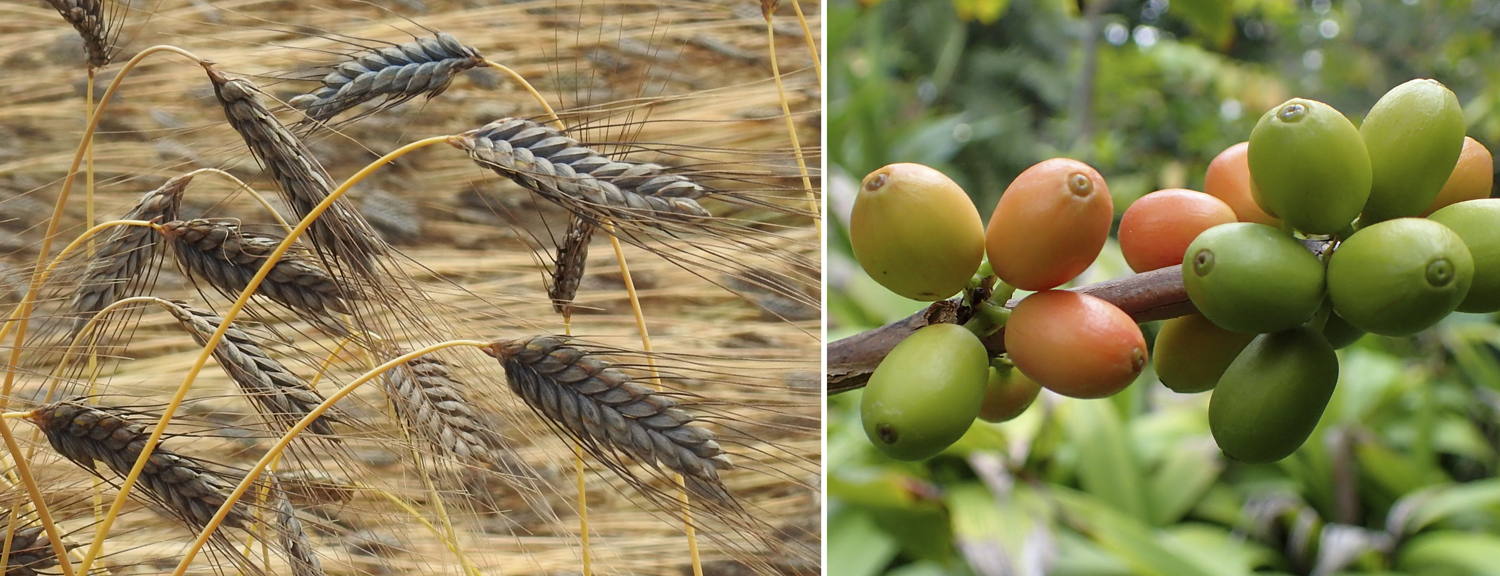
Economically important plants. Left: Black emmer wheat (Triticum dicoccum var. atratum). Right: Coffee cherries (Coffea arabica). Credits: Triticum dicoccum (Robert Flogaus-Faust, via Wikimedia Commons, CC BY-SA 4.0); Coffea arabica 'Nazareth' (Krzysztof Ziarnek, Kenraiz, via Wikimedia Commons, CC BY-SA 4.0). Images modified from originals.
Angiosperms show many different modifications and adaptations for defense, support, procuring nutrition, and living in challenging environments. Some are armed with prickles, spines, or thorns, or have tendrils for climbing. Some are carnivorous, employing methods—such as pitfall traps, sticky traps, and snap traps—to ensnare their prey. Others are parasitic, deriving nutrition from host plants.
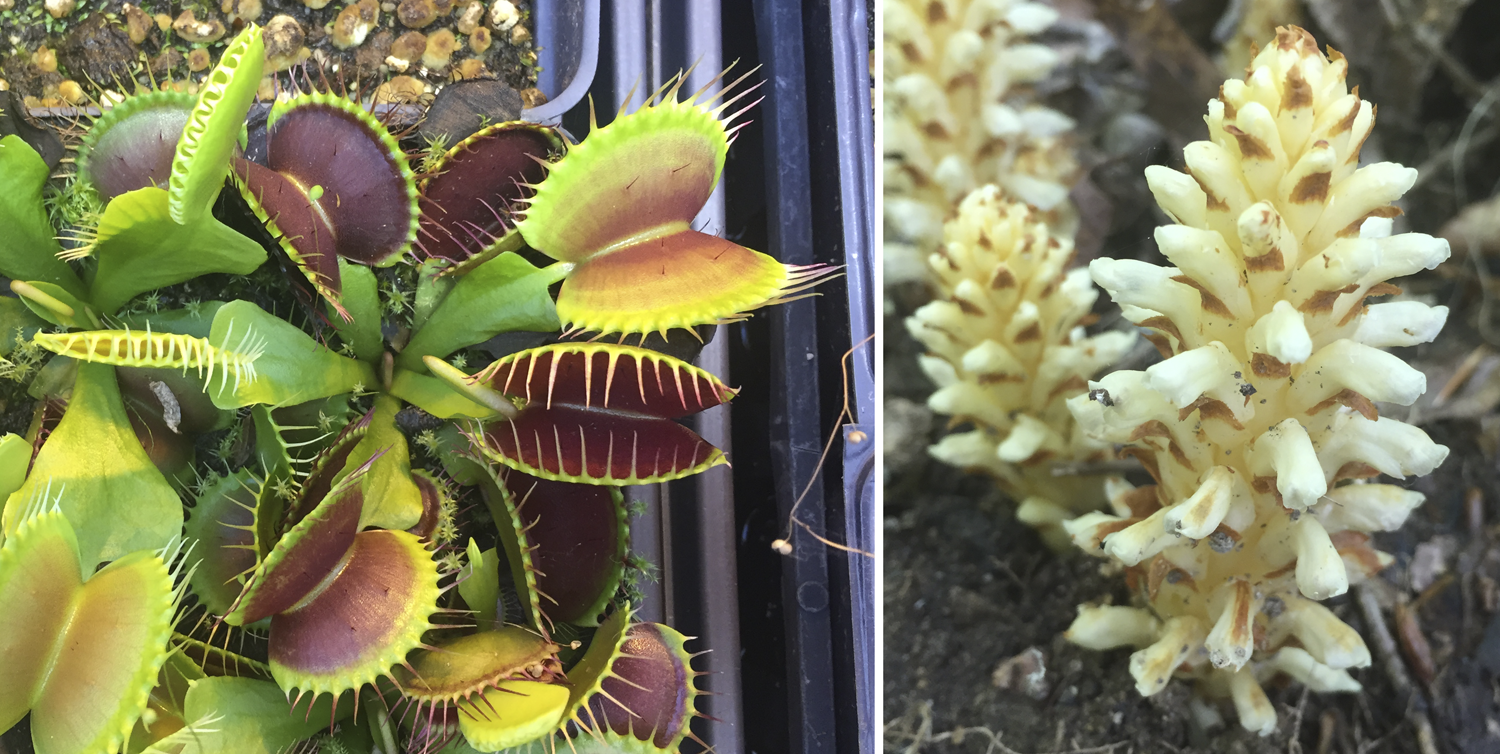
Carnivores and parasites. Left: Venus flytrap (Dionaea muscipula) is one of only two species of angiosperms with snap-traps for catching prey. So-called "carnivorous" plants capture prey in order to get essential nutrients, like nitrogen. Right: American cancer-root (Conopholis americana) parasitizes oaks (Quercus). Credits: Images by E.J. Hermsen (DEAL).
The reproductive structures and life cycle innovations of angiosperms readily set them apart from other groups of plants. The reproductive structure of angiosperms is the flower. While a flower can be considered a type of strobilus, or cone, angiosperm flowers have some obvious differences from cones found in other groups of plants. They often have colorful petals, and their pollen-producing structures are highly modified and called stamens. Perhaps most notably, however, their ovules are enclosed an ovary. When the ovary ripens, it become a fruit that encloses the seeds. In fact, the ovary or fruit is the feature to which the name "angiosperm" (Greek, angeion + sperma = container + seed) refers (in other words, angiosperm seeds are kept in a container).
Although there are reports of pre-Cretaceous angiosperm fossils, the credible fossil record of the angiosperms begins in the Early Cretaceous. The stem group leading to the angiosperms could be far older. There is no general consensus regarding which gymnosperm group gave rise to the angiosperms. Angiosperms diversified during the Cretaceous period, and plants that show clear relationships to many modern flowering plant families can be identified in the fossil record by the Late Cretaceous. By the Cenozoic, many modern genera can be identified from fossil remains. In the last 66 million years, shifting continents, land bridges, and environmental changes shaped the diversity and geographic distributions of angiosperms as they occur today.
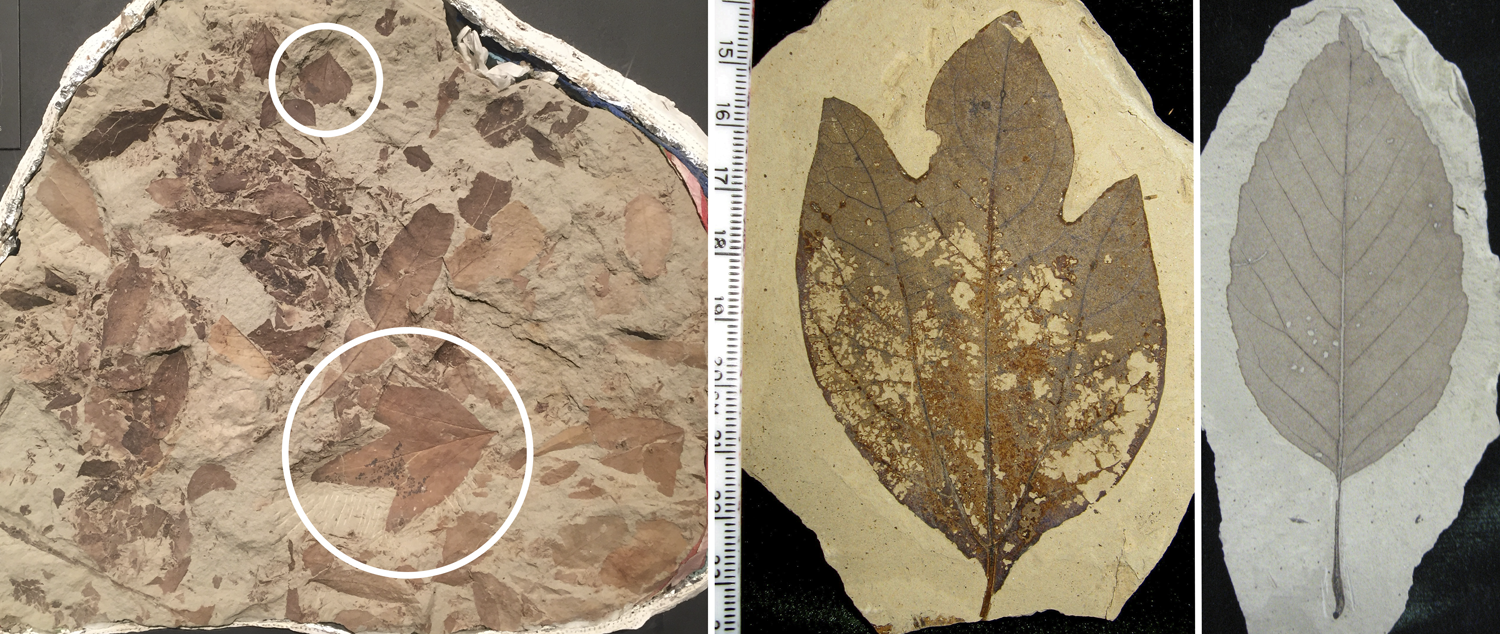
Cretaceous and Paleogene angiosperm fossils. Left: A slab of leaves from the Upper Cretaceous Hell Creek Formation, western U.S.A. The leaf in the upper circle is from a member of the angiosperm family Trochodendraceae, whereas the leaf in the bottom circle is Erlingdorfia montana (Plantanaceae, plane-tree family). Leaves of other angiosperms and the extinct gymnosperm Nilssoniocladus also occur on the slab. Center and right: Leaves of sassafras (Sassafras hesperia) and alder (Alnus parvifolia) from the Eocene Republic flora (Klondike Mountain Formation, Washington, U.S.A.). Credits: Hell Creek leaves, U.S. National Museum of Natural History specimen USNM 606565 (E.J. Hermsen, DEAL); Sassafras hesperia and Alnus parviflora (SR 02-22-20) specimens from the Stonerose Interpretive Center, Republic, Washington, U.S.A. (Kevmin, via Wikimedia Commons, CC BY-SA 3.0).
Selected references & further reading
Note: Free full text is made available by the publisher for items marked with a green star.
Academic articles
* Christenhusz, M.J.M., and J.W. Byng. 2016. The number of known plant species in the world and its annual increase. Phytotaxa 261: 201–217. https://doi.org/10.11646/phytotaxa.261.3.1
* Rogers, P.C., and D.J. McAvoy. 2018. Mule deer impede Pando's recovery: Implications for aspen resilience from a single-genotype forest. PLoS ONE 13(10): e0203619. https://doi.org/10.1371/journal.pone.0203619
* Tng, D.Y.P., G.J. Williamson, G.J. Jordan, D.M.J.S. Bowman. 2012. Giant eucalypts—globally unique fire-adapted rain-forest trees? New Phytologist 196: 1001–1014. https://doi.org/10.1111/j.1469-8137.2012.04359.x
White, S.L., and R.R. Wise. 1998. Anatomy and ultrastructure of Wolffia columbiana and Wolffia borealis, two nonvascular aquatic angiosperms. International Journal of Plant Sciences 159: 297–304. https://doi.org/10.1086/297550
Books & textbooks
Evert, R.F., and S.E. Eichhorn. 2013. Raven Biology of Plants, 8th ed. W.H. Freeman and Co., New York, New York.
Friis, E.M., P.R. Crane, and K.R. Pedersen. 2011. Early Flowers and Angiosperm Evolution. Cambridge University Press, Cambridge, U.K.
Simpson, M.G. 2010. Plant Systematics, 2nd ed. Academic Press, Burlington, Massachusetts.
Websites
* Carnivorous plants/Insectivorous Plants. Botanical Society of America. https://botany.org/Carnivorous_Plants/
* Jaunzems, M. [no date.] Plant of the week: American cancer-root (Conopholis americana (L.) Wallr.). U.S.D.A. Forest Service Celebrating Wildflowers. https://www.fs.fed.us/wildflowers/plant-of-the-week/conopholis_americana.shtml
* Pando-(I spread). Fishlake National Forest, USDA Forest Service. https://www.fs.usda.gov/detail/fishlake/home/?cid=STELPRDB5393641
* Soltis, P., D. Soltis, and C. Edwards. 2005. Angiosperms, flowering plants. Ver. 03 June 2005 in The Tree of Life Web Project. http://tolweb.org/Angiosperms/20646/2005.06.03
* Stevens, P.F. 2001 onwards. Angiosperm phylogeny website [continuously updated]. http://www.mobot.org/MOBOT/research/APweb
Content usage
Usage of text and images created for DEAL: Text on this page was written by Elizabeth J. Hermsen. Original written content created by E.J. Hermsen for the Digital Encyclopedia of Ancient Life that appears on this page is licensed under a Creative Commons Attribution-NonCommercial-ShareAlike 4.0 International License. Original images and diagrams created by E.J. Hermsen are also licensed under Creative Commons Attribution-NonCommercial-ShareAlike 4.0 International License.
Content sourced from other websites: Attribution, source webpage, and licensing information or terms of use are indicated for images sourced from other websites in the figure caption below the relevant image. See original sources for further details. Attribution and source webpage are indicated for embedded videos. See original sources for terms of use. Reproduction of an image or video on this page does not imply endorsement by the author, creator, source website, publisher, and/or copyright holder.
Adapted images. Images that have been adapted or remixed for DEAL (e.g., labelled images, multipanel figures) are governed by the terms of the original image license(s) covering attribution, general reuse, and commercial reuse. DEAL places no further restrictions above or beyond those of the original creator(s) and/or copyright holder(s) on adapted images, although we ask that you credit DEAL if reusing an adapted image from the DEAL website. Please note that some DEAL figures may only be reused with permission of the creator(s) or copyright holder(s) of the original images. Consult the individual image credits for further details.
Last updated 1 April 2020.



